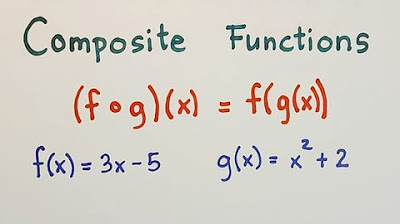A Tale of Three Functions | Intro to Limits Part I
Summary
TLDRThis video explores the concept of limits by comparing three functions: f(x) = x + 1, g(x) = (x^2 - 1)/(x - 1), and h(x), a piecewise function. While f(x) is a simple linear function, g(x) appears similar but is undefined at x = 1 due to division by zero. The piecewise function h(x) equals x + 1 for all x except x = 1, where it is defined as 3. The video illustrates how these functions are almost identical except at specific points, highlighting the subtle differences in their domains and values at x = 1.
Takeaways
- 🔍 The video explores the concept of limits by comparing three functions: f(x), g(x), and h(x).
- 📈 f(x) is defined as a straight line with the formula x + 1 and is graphed accordingly.
- 🔢 g(x) is given by the formula x^2 - 1 / (x - 1), which can be factored to x + 1, but g(x) is not defined at x = 1 due to division by zero.
- 🚫 The graph of g(x) has a hole at x = 1, indicating that the function is undefined at that point.
- 📉 h(x) is a piecewise function with h(1) = 3 and h(x) = x + 1 for all other x values, making it different from f(x) and g(x) at x = 1.
- 📊 The graph of h(x) has a distinct point at x = 1 with a value of 3, unlike f(x) and g(x).
- 🤔 The video emphasizes the importance of understanding the domain of a function and how it can differ between similar-looking functions.
- 🧩 The functions f(x), g(x), and h(x) are mostly the same except at x = 1, highlighting the significance of specific points in function analysis.
- 📋 The script illustrates how to graph functions with special points, such as holes and distinct values, to visualize their behavior.
- 💡 The concept of limits is introduced as a way to understand how functions behave as they approach certain points, even if they are not defined there.
Q & A
What is the main concept discussed in the video?
-The main concept discussed in the video is the idea of a limit, and how it is used to analyze the similarities and differences between three different functions: f(x), g(x), and h(x).
What is the formula for the function f(x)?
-The formula for the function f(x) is f(x) = x + 1.
How is the function g(x) initially defined and what does the instructor suggest to do with such functions?
-The function g(x) is initially defined as g(x) = (x^2 - 1) / (x - 1). The instructor suggests factoring the numerator and checking if there is anything that can be cancelled with the denominator.
What happens when you cancel the common term in g(x)?
-When you cancel the common term (x - 1) from the numerator and the denominator in g(x), you are left with x + 1, which is the same as f(x).
At what value of x does g(x) have a problem?
-g(x) has a problem at x = 1 because it results in division by zero, which is undefined.
How is the graph of g(x) different from f(x)?
-The graph of g(x) is almost the same as f(x), but it has a hole at x = 1 where the function is not defined, represented by a circle with a hole in the graph.
What is the definition of the function h(x)?
-The function h(x) is a piecewise defined function where h(x) = 3 when x = 1, and h(x) = x + 1 for all other values of x.
How does the graph of h(x) differ from the graphs of f(x) and g(x)?
-The graph of h(x) is the same as f(x) for all values except x = 1, where it has a distinct point at (1, 3), which is different from the hole in g(x) and the regular line in f(x).
What is the domain of the function g(x)?
-The domain of g(x) is all real numbers except x = 1, because at x = 1, the function is undefined due to division by zero.
How do the values of f(x), g(x), and h(x) compare at x = 1?
-At x = 1, f(x) = 2, g(x) is undefined, and h(x) = 3.
What is the main takeaway from comparing these three functions?
-The main takeaway is that while f(x), g(x), and h(x) may look similar, they are not identical due to differences in their definitions and behaviors at specific points, particularly at x = 1.
Outlines

This section is available to paid users only. Please upgrade to access this part.
Upgrade NowMindmap

This section is available to paid users only. Please upgrade to access this part.
Upgrade NowKeywords

This section is available to paid users only. Please upgrade to access this part.
Upgrade NowHighlights

This section is available to paid users only. Please upgrade to access this part.
Upgrade NowTranscripts

This section is available to paid users only. Please upgrade to access this part.
Upgrade Now5.0 / 5 (0 votes)





